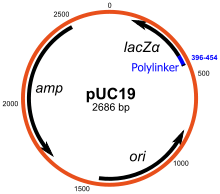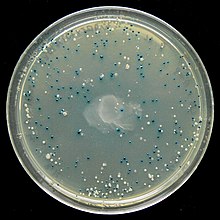Cloning vector

A cloning vector is a small piece of
There are many types of cloning vectors, but the most commonly used ones are genetically engineered
Features of a cloning vector
All commonly used cloning vectors in
Cloning site
All cloning vectors have features that allow a gene to be conveniently inserted into the vector or removed from it. This may be a
Other cloning vectors may use topoisomerase instead of ligase and cloning may be done more rapidly without the need for restriction digest of the vector or insert. In this TOPO cloning method a linearized vector is activated by attaching topoisomerase I to its ends, and this "TOPO-activated" vector may then accept a PCR product by ligating both the 5' ends of the PCR product, releasing the topoisomerase and forming a circular vector in the process.[2] Another method of cloning without the use of DNA digest and ligase is by DNA recombination, for example as used in the Gateway cloning system.[3][4] The gene, once cloned into the cloning vector (called entry clone in this method), may be conveniently introduced into a variety of expression vectors by recombination.[5]
Selectable marker
A
Another kind of selectable marker allows for the positive selection of plasmid with cloned gene. This may involve the use of a gene lethal to the host cells, such as barnase,[8] Ccda,[9] and the parD/parE toxins.[10][11] This typically works by disrupting or removing the lethal gene during the cloning process, and unsuccessful clones where the lethal gene still remains intact would kill the host cells, therefore only successful clones are selected.
Reporter gene
Reporter genes are used in some cloning vectors to facilitate the screening of successful clones by using features of these genes that allow successful clone to be easily identified. Such features present in cloning vectors may be the
Elements for expression
A cloning vector need not contain suitable elements for the
Cloning vectors without promoter and RBS for the cloned DNA sequence are sometimes used, for example when cloning genes whose products are toxic to E. coli cells. Promoter and RBS for the cloned DNA sequence are also unnecessary when first making a genomic or cDNA library of clones since the cloned genes are normally subcloned into a more appropriate expression vector if their expression is required.
Some vectors are designed for transcription only with no heterologous protein expressed, for example for in vitro mRNA production. These vectors are called transcription vectors. They may lack the sequences necessary for polyadenylation and termination, therefore may not be used for protein production.
Types of cloning vectors
A large number of cloning vectors are available, and choosing the vector may depend upon a number of factors, such as the size of the insert, copy number and cloning method. Large insert may not be stably maintained in a general cloning vector, especially for those with a high copy number, therefore cloning large fragments may require more specialised cloning vector.[6]

Plasmid
Plasmids are autonomously replicating circular extra-chromosomal DNA. They are the standard cloning vectors and the ones most commonly used. Most general plasmids may be used to clone DNA inserts of up to 15 kb in size. One of the earliest commonly used cloning vectors is the pBR322 plasmid. Other cloning vectors include the pUC series of plasmids, and a large number of different cloning plasmid vectors are available. Many plasmids have high copy numbers, for example, pUC19 has a copy number of 500-700 copies per cell,[6] and high copy number is useful as it produces greater yield of recombinant plasmid for subsequent manipulation. However low-copy-number plasmids may be preferably used in certain circumstances, for example, when the protein from the cloned gene is toxic to the cells.[12]
Some plasmids contain an M13 bacteriophage origin of replication and may be used to generate single-stranded DNA. These are called phagemids, and examples are the pBluescript series of cloning vectors.
Bacteriophage
The bacteriophages used for cloning are the
There is also a lower size limit for DNA that can be packed into a phage, and vector DNA that is too small cannot be properly packaged into the phage. This property can be used for selection - vector without insert may be too small, therefore only vectors with insert may be selected for propagation.[15]
Cosmid
Bacterial artificial chromosome
Insert size of up to 350 kb can be cloned in
.Yeast artificial chromosome
Yeast artificial chromosome are used as vectors to clone DNA fragments of more than 1 mega base (1Mb=1000kb) in size. They are useful in cloning larger DNA fragments as required in mapping genomes such as in the Human Genome Project. It contains a telomeric sequence, an autonomously replicating sequence (features required to replicate linear chromosomes in yeast cells). These vectors also contain suitable restriction sites to clone foreign DNA as well as genes to be used as selectable markers.
Human artificial chromosome
Human artificial chromosome may be potentially useful as a gene transfer vectors for gene delivery into human cells, and a tool for expression studies and determining human chromosome function. It can carry very large DNA fragment (there is no upper limit on size for practical purposes), therefore it does not have the problem of limited cloning capacity of other vectors, and it also avoids possible insertional mutagenesis caused by integration into host chromosomes by viral vector.[16][17]
Animal and plant viral vectors
Viruses that infect plant and animal cells have also been manipulated to introduce foreign genes into plant and animal cells. The natural ability of viruses to adsorb to cells, introduce their DNA and replicate have made them ideal vehicles to transfer foreign DNA into eukaryotic cells in culture. A vector based on Simian virus 40 (SV40) was used in first cloning experiment involving mammalian cells. A number of vectors based on other type of viruses like Adenoviruses and Papilloma virus have been used to clone genes in mammals. At present, retroviral vectors are popular for cloning genes in mammalian cells. In case of plants like Cauliflower mosaic virus, Tobacco mosaic virus and Gemini viruses have been used with limited success.

Screening: example of the blue/white screen
Many general purpose vectors such as
See also
References
- ^ "Definition of cloning vector". Genome Dictionary. Retrieved 2012-10-18.
- ^ "The Technology Behind TOPO® Cloning". Invitrogen.
- PMID 18988017.
- ^ "Cloning Methods - Recombination cloning systems". EMBL.
- ^ "Gateway® Recombination Cloning Technology". Invitrogen.
- ^ ISBN 978-1-58829-151-6.
- S2CID 15674832.
- PMID 8635737.
- PMID 8862819.
- PMID 10769758.
- S2CID 10312859.
- ^ "Copy number". Genetics Institute, Inc. Archived from the original on 2013-04-19. Retrieved 2013-03-06.
- PMID 1480110.
- ISBN 9781555816124.
- ISBN 978-1444334074.
- PMID 22123967.
- PMID 22907415.
